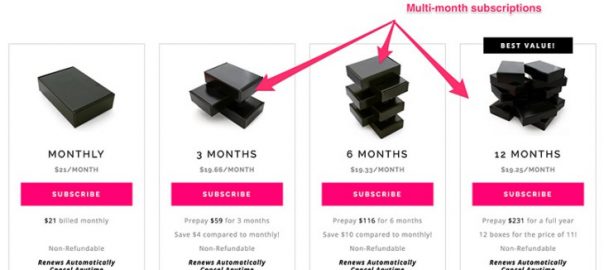
We’ve all heard the saying “Cash is King”. And it’s true: Cash is the lifeblood of a business.
From being able to make payroll to paying supplier invoices to paying recurring bills like utilities and rent, the necessity of having adequate cash on hand is crucial for a business to be able to operate smoothly. Should cash not be managed properly, a business may have to turn to costly loans or defer paying bills.
For your subscription business, this lesson is most pronounced when dealing with multi-month subscriptions. You’ve probably seen these offered (or maybe you offer them yourself):

Checkout Example: BoxyCharm
It’s pretty simple: With multi-month commitments, you receive cash up-front from a subscriber for the promise of future deliveries to that subscriber.
The implications can be a bit more complex. These future deliveries are now a liability of the business, and will require a certain amount of cash each month to fulfill these liabilities.
Let’s look at an example:
A Single Cohort Example: Selling 100 6 Month Subscriptions
Note: for this example, we’ll ignore credit card transaction and processing fees and potential discounts with extended subscriptions.
Using the numbers from the How to Price Your Subscription Box 60-Second Sesh, let’s start with a basic example of a company that sells 6-month subscriptions with a Cost of Goods Sold (COGS) of $ 20.95 with a sales price of $ 38.95 per month.
Ignoring the monthly discounts potentially offered to a customer for purchasing a multi-month subscription, let’s say 100 6-month subscriptions are sold.
This would produce a cash INFLOW of $ 23,370 ($ 38.95 * 6 * 100).
The immediate cash OUTFLOW (Month 1) directly associated with these new subscribers would be the fulfillment of the first month of their six-month subscription: 100 subscribers * $ 20.95 of fulfillment costs, or $ 2,095.
This leaves $ 21,275 as a net cash inflow from these 100 new subscribers in the first month.
Before you celebrate, you have realize this isn’t all profit.
The majority of this cash inflow has not yet been earned. Remember, there are still five months that require fulfillment to these customers.
The future cash outflows required to fulfill the subscriptions of these 100 new customers is $ 10,475
$ 20.95 * 5 months * 100 boxes = $ 10,475
In other words, over the next five months these 100 subscribers will require a cash outflow of $ 10,475 ($ 2,095/month) in order to fulfill the obligations resulting from their subscription purchases.
With this, you can see the actual net cash inflow from these subscriptions after Month 1 is $ 10,800:
$ 21,275 – $ 10,475 = $ 10,800
Here, $ 10,800 is the actual remaining contribution margin generated by these customers. After Product and Fulfillment costs (for the life of the subscriptions) are deducted, this is the true gross margin of these sales.
Contribution margin is the amount of proceeds available from a sale after COGS are deducted. ie: the amount left over to cover fixed costs, administrative costs, and ultimately what will be left over as profits.
Extended Subscriptions Create a Fulfillment Liability
In the example above of the 100 6-month subscriptions, it may be tempting to use the $ 21,275 cash inflow for other business uses, such as additional customer acquisition & marketing opportunities, salaries, or something else.
But the future five-months of these plans are a liability of the company, and this liability will ultimately require the use of cash to eliminate.
For example, let’s assume that the cash inflow of $ 21,275 after the fulfillment of the first month is used in its entirety for business purposes other than fulfillment. This leaves $ 0 cash from this 100 customer cohort to cover the remaining five months of shipments to these customers.
If the remaining five months of this first cohort are unfunded, how are you going to pay for those products, boxes, and shipping? The cash required to fulfill these shipments ($ 10,475) will have to come from somewhere.
Couldn’t I just sell another 100 subscriptions?
This is where the rabbit hole starts.
It may be tempting to use the cash inflows of the next 100 subscribers to fulfill the liability of the previous subscribers. However, this reduces the amount available for the fulfillment of this second cohort. This cash will then need to come from somewhere else, just like with the first cohort.
You can see that this type of cash flow pattern continues to leave an unfunded liability that could spiral out of control, leaving a greater and greater number of future shipments unfunded.
A Simple but Important Lesson: Realize Revenue at the Right Time
It is important to be cognizant of your future fulfillment obligations and disciplined in your use of cash — it’s will invariably impact the stability of your business.
A pattern of relying too heavily on the upfront cash received by new subscribers to fund the fulfillment liabilities of existing subscribers will lead to cash flow problems down the road. Hands down.
Questions? Start a conversation below.
Business & Finance Articles on Business 2 Community(64)






